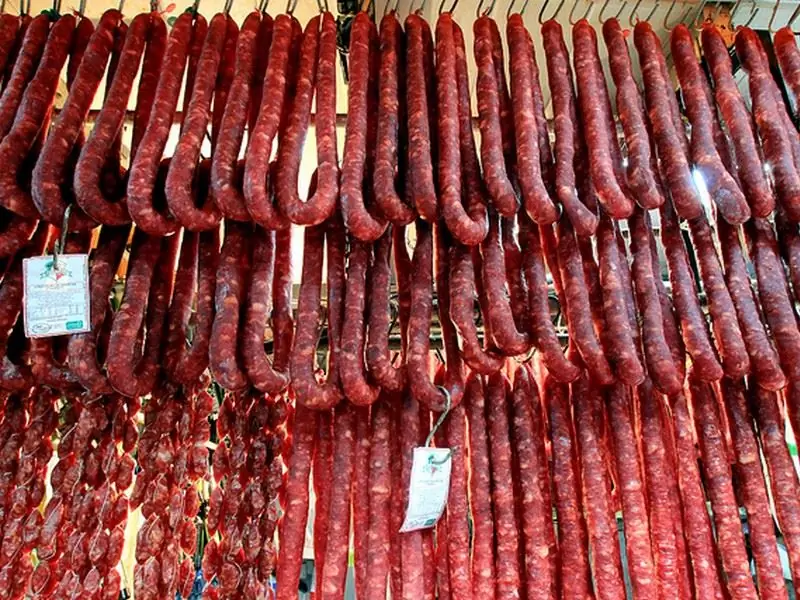2025 Author: Isabella Gilson | [email protected]. Last modified: 2025-01-23 12:50:45
Sausages are a fast food product. To bring them "to mind", it takes from 7 to 10 minutes. They can be fried, boiled, consumed with various products, such as: pasta, cereals, potatoes, and so on. Choose for yourself with which side dish you will enjoy the wonderful taste of this type of sausage. They are prepared from the meat of almost all types of animals and birds belonging to the livestock industry.

Sausages distinguish:
- "Dairy";
- "Munich";
- "Diet";
- "Bavarian";
- soy meat sausages;
- grilled sausages;
- chicken, beef, pork.
The history of sausages, according to one version, originates about two thousand years ago, back in the days of Ancient Rome. According to another, in a town located in Germany, a man named Johann Lanner started the production of these products at the beginning of 19century. Whatever their history, sausages were invented to increase the variety of food on the festive and everyday table of the poor. A two-meter monument was erected to Lanner as a token of gratitude for the invented delicacy.
Sausages are one of the most convenient forms of meat storage. This product has a longer shelf life than a regular meat product. In ancient times, the production of sausage products increased and developed in stages. They were prepared from the remains of meat, fat, brains, blood, lungs. The contents were mixed together and ground for a variety of taste.
In the 19th century, a new recipe for making sausages from a mixture of beef and pork meat was first developed. Thanks to this, new types of these products appeared: smoked, dried and others. People who once tried this type of product found it difficult to resist their alluring appearance. They bought or made sausages themselves, using folk, time-tested recipes. Thus, a large-scale industry for their production was born.
In the USSR, a major development in the production of sausages began in 1936 after the signing of a decree on the production of various meat and sausage products. Thanks to this, about thirty meat processing plants were built on the territory of large cities. The availability of equipment for the production of sausages made it possible to mass-produce these products on the country's markets.
According to GOST in the USSR, the meat content in sausages was about fifty percent. Now it is much less, about thirty percent.

Learning to store sausages
When buying products in the store or making them at home, we are faced with the problem of their safety. People have a question about the methods and terms of storage of these products. The shelf life of sausages depends on the products from which they are made. To keep this product for a long time, various preservatives are added to it. Their composition also affects the shelf life of sausages.
Now it's hard to find natural products in stores without any harmful additives. Manufacturers "mix" preservatives into sausages in large quantities, which helps to preserve the presentation of the product for a long time. The shelf life of the product also depends on the quality of the packaging. In sealed, vacuum containers, sausages last much longer.

Shelf life of sausage products
The expiration date of sausages according to GOST is set differently. The presence of vacuum packaging provides a period of up to 35 days. For artificial or natural casings, it ranges from 5 to 10 days. Sausages made to specifications are good for 40 days.

Storage of sausage products
To increase the shelf life of sausage products, be sure to put the products in the refrigerator. When buying this product in a store, pay attention to their appearance. They must have an expiration date and date of manufacture. The shelf life of sausages in the refrigerator depends on the date of production. If during storage the number of days indicated on the package was not exceeded, thenthe product may be considered fit for consumption.
There are different types of sausage casings. In natural casings, they are stored for 72 hours. Items wrapped in cellophane will be stored for two days.
In polyamide packaging, sausages have a shelf life of 8 to 10 days. With further storage, they lose their taste. The recommended storage temperature for the product is 3 to 8 degrees Celsius.

Attention
If sausages were stored for a long time in a warm place, then various microorganisms get into them, which adversely affect the products. It is not recommended to use such sausages if the storage conditions are violated, as this can be harmful to your he alth.
Freezer storage
The temperature in the freezer allows you to store sausages for up to two months. After 60 days, they lose all their taste. The same applies to keeping sausage products in the freezer for more than two months.
The shelf life of boiled sausages is no more than one week. They can be stored in the freezer for about a month. Cooked products are best packed in a plastic box. Opened storage of the product in the refrigerator is not recommended. The shelf life of boiled sausages according to GOST of the highest and medium grade is forty-eight hours. For boiled sausages, this period is limited to seventy-two hours.

Storage "Milk" sausages
"Milk" sausages consist ofmany products. Their standard composition includes: beef, pork, milk powder, s alt, egg powder and spices. With such a quantity of ingredients, the shelf life of this product according to GOST is from 10 to 15 days in a closed package. "Milk" sausages labeled "Special" or "Creamy" are the highest quality product. Naturally, they have a longer shelf life than other types of these products. Lower quality "Milk" sausages are limited to 12 days.
Sausage is a meat product, it refers to both sausages and sausages. It differs from sausage in its thick and short shape. Sausage comes from the word "Sardine". The expiration dates of sausages and wieners are almost the same.
Several types of minced meat are used for the production of these products. For example: pork, beef, soybeans, sugar, s alt, dyes, milk powder, fat additives, bacon, flavors and other types of products. Sausages "Spikachki" appeared as a result of adding bacon to the composition.
There are sanitary and epidemiological rules and regulations for the storage of sausages and sausages, as well as other meat products. According to the GOST standards, sausages, boiled sausages, packed in vapor-gas-tight casings, can be stored for up to 7 days. The shelf life of sausages, sausages, produced according to GOST, is 72 hours - the highest grade, the lowest - 48 hours. Sausages cut and packed under vacuum, as well as boiled, are stored for five days.
Cooked sausages have their own technical approvals for sale. Allowed:
- weight increase due to table s alt in the warm period by 0.2% - in the months from May to September;
- on the section of sausages the presence of fine porosity;
- condensation in vacuum packaging, simple sausage packaging.
Sausages are not allowed for sale:
- with dirty shell;
- with the presence of loose minced meat;
- with gray bars;
- if there are broth-fat secretions;
- the presence of a violation of the packaging shell or bars in which the product is stored.
Helpful tips
Sausages should have a soft pink color. If there are bright shades on the product, then this indicates the presence of dyes in the product. The color of quality sausages is uniform and has no shades.
Natural, fresh sausages have a dry and smooth surface. The detection of mucus on the coating of the product indicates that the sausages are spoiled. The elasticity and elasticity of sausages also speaks of their condition. If they break, it means that there is a lot of starch in the composition.
The package of sausages must be whole and unharmed. Pay attention to the expiration date when buying. Usually, the maximum shelf life of sausage products in stores is about 12-15 days. When storing at home, pay attention to the date of manufacture.

Useful properties of sausages
This is a product loved by many people. They contain many useful properties. Great benefit brings the use of "Milk" sausages. They containvitamins that are important for the metabolism in our body. The presence of vitamin PP helps to reduce cholesterol levels in the blood. Sodium, which is part of the product, restores blood pressure and maintains the balance of water in the body.
Sausages are a high-calorie food. They have a high energy value. Sausages fried at the stake are less harmful due to natural heat treatment. The temperature of the fire on the fire is higher than when cooking on gas. They are substitutes for breakfast, dinner, lunch. And also well-fried sausages look beautiful on the festive table. They are quite inexpensive and can replace any meat. Gathered for a hike - bring sausages with you!
Harm of sausages
Products of lower quality contain a large number of various harmful substances that are unacceptable to the human body. It is not recommended to use sausages for children under three years old, as well as for pregnant women, people suffering from diseases of the stomach, liver, bladder, heart and diabetes. It is advisable not to use the shell of the product, as it contains harmful substances.
Recommended:
Yogurt: expiration date, storage conditions

Yogurt is a variety of fermented milk products enriched with beneficial bacteria that restore the functioning of the gastrointestinal tract and improve the intestinal microflora. In pursuit of brands that are full of TV screens, people rarely think about the expiration date of the drink. What determines the life span of a fermented milk product? What is the expiration date of yogurt, indicated on the package, will reveal the secrets of its quality? The answers are in the article
Types and varieties of sausages: classification, taste characteristics and compliance with GOST requirements

Today there is a huge number of various types and varieties: boiled, raw-smoked and boiled-smoked sausages. They differ not only in the method of processing, but also in the type and composition of raw materials, in the pattern of minced meat on the cut and type of shell, in nutritional value and quality, which, in turn, is determined by the color, taste and smell of the product
Expiration date of cottage cheese. General storage advice for this product

It's no secret that cottage cheese is considered one of the he althiest dairy products. However, it cannot be stored in the refrigerator for a long time and after a short period of time it begins to lose taste and valuable substances. In addition, the use of a spoiled product is fraught with serious problems with the gastrointestinal tract. From this article you will learn the exact expiration date of cottage cheese and the rules for its storage
Coffee: expiration date, types, taste, storage rules and cooking tips

This article will help the reader understand the main types of coffee beans, their characteristics and taste. Briefly talk about the history of the origin of the coffee drink, as well as the basic conditions for its storage and expiration dates, the basic rules for making coffee
Linseed oil: expiration date and storage rules, recommendations

What is the shelf life of linseed oil? How to store it correctly? How to use? We will answer these and other questions in the article. This information will be useful to every hostess. Flaxseed oil is a plant-based product that is obtained from flax seeds. Drying oil, varnish is prepared from it. Also used for the production of linoleum and oil paints, which are used by artists and even in construction. Flaxseed oil has long been known for its use in traditional medicine

